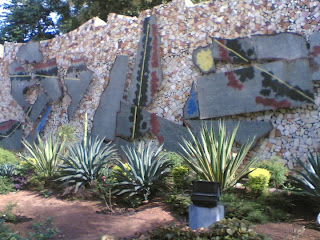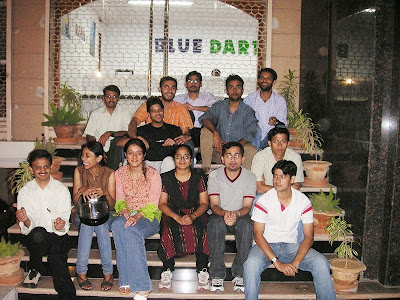Friday, August 29, 2008
Ch. Mohan Rao's Group
Born in Huzurabad, Andhra Pradesh, Mohan Rao has obtained his B.Sc. degree from the Arts and Science College (Osmania University), Warangal and M.Sc.(Physical Chemistry) form Kakatiya University, Warangal. Then he moved to the University of Hyderabad for a Ph.D. programme in chemistry. During the Ph.D. programme, he worked on photoacoustic spectroscopy of chemical and biological systems. This work also involved modification and improvement of the system, data acquisition and processing software.
Later he joined CCMB and initiated intact lens spectroscopic investigation. During 1990-92, he visited National Eye Institute of the National Institutes of Health, Bethesda, USA and carried out investigations on stability of crystallins and the role of nucleotides in the damage to eye lens due to exposure to ultraviolet light. On his return he initiated work on protein folding in health and disease, particularly molecular chaperone like property of alpha-crystallin and its relation to cataract, neurodegenerative diseases and cardiomyopathy. He is also investigating other heat-shock proteins such as hsp22 and hsp33.
He was a visiting Professor at the Tokyo Science University, Japan during 1996, Visiting Scientist (Raman Fellow) at the University of Texas Medical Branch, Galveston, USA during 2000, Visiting Professor at the Institute for Protein Research, Osaka, Japan during 2002. He is a Fellow of Indian National Science Academy, National Academy of Sciences, Indian Academy of Science and Andhra Pradesh Akademi of Sciences. He was awarded the Shanthi Swarup Bhatnagar Prize in 1999.
Ch.Mohan Rao's Group members
Name Designation Extn. No. E-mail
Ch. Mohan Rao Scientist 2543 mohan@ccmb.res.in
K Sridhar Rao Scientist 2558 sreedhar@ccmb.res.in
V Srinivas Technical Office 2556 volety@ccmb.res.in
B. Raman Technical Officer 2558 raman@ccmb.res.in
P Hanumanthu Group I 2555
V Anuradha Technician 2529
Md. Faiz Ahmad Senior Research Fellow 2555
Abhay Kumar Thakur Senior Research Fellow 2555 abhay@ccmb.res.in
Bhairab Nath Singh senior Research Fellow 2559 bnsigh@ccmb.res.in
Aftab Taiyab senior Research Fellow 2557 ataiyab@ccmb.res.in
Abhishek Asthana senior Research Fellow 2555
S Prabhu Junior Research Fellow 2560 prabhus@ccmb.res.in
Saad Mohammad Ahsan Junior Research Fellow 2557 saadmahsan@ccmb.res.in
Abdullah Sultan Junior Research Fellow 2555 abdullah@ccmb.res.in
V Jagadish Project Asstt. 2778
R Shalini Project Asstt. 2778
P Suhardra Project Asstt. 2778
PM Bhargava The founder director of ccmb
It is his vision that - `a Centre for research in frontier areas of modern biology at par with those in Western countries can be built and maintained in India too' - led to what CCMB is today as acclaimed by many distinguished people. His vision of the establishment of CCMB fulfilled a long-felt need in the country for providing the necessary thrust in molecular and cellular biology. CCMB is the first institution in India devoted exclusively to research in frontier-areas of modern biology and it has played a key role in the development of Biotechnology programme in the country.
The results of the care and attention to detail that Dr Bhargava evinced at every step are visible - in the laboratories as well as in the beautiful green surroundings. His experiment in forging a novel framework for the sharing of all facilities, equipment and chemicals amongst the scientific groups is unique in Indian set-up. In effect, this means that the CCMB functions as one integrated laboratory; and so far this experiment has been successful. He is a firm believer in that science and art are the two facets of creative human activity and they go hand in hand. His penchant for aesthetics reflects at various places in the CCMB campus. Dr Bhargava's continued association and support to CCMB is a great help to maintain and improve these traditions.
The Centre, formally set up as an autonomous organisation in 1977, moved to its own modern building complex and was dedicated to the nation by the then Prime Minister, Mr Rajiv Gandhi, on 26th November 1987. The inaugural function was attended by a galaxy of distinguished scientists including few Nobel Laureates such as Dr F H C Crick, Dr C D Gajdusek, Dr B S Blumberg, Dr J C Kendrew, Dr Georges Kohler and Dr S O Choa.
R.Sankaranarayanan's Group
He joined the Centre for Cellular and Molecular Biology (CCMB), Hyderabad as a senior scientist in March 2002. He has setup a state-of-the-art macromolecular crystallography laboratory in the institute and carrying out research in the field of Structural Biology. His research interests are in trying to understand intermolecular recognition mechanisms. One major area of focus in his laboratory is in elucidating how very similar substrates are recognized with a high accuracy in order to achieve a faithful translation of the genetic code. The other areas of research in his laboratory includes understanding the structural basis of functional interplay between polyketide synthases and fatty acid synthases in Mycobacterium tuberculosis, structure-function studies on virulence factors of a rice pathogenic bacteria and structure guided design of thermostable lipases.
Rakesh Mishra's group
Senior Scientist
Centre for Cellular and Molecular Biology
Uppal Road
Hyderabad 500 007
India.
Email: mishra@ccmb.res.in
Telephone: (+ 91) 40 2719 2658
Fax No: (+ 91) 40 2716 0591
Our lab is interested in higher order chromatin structure in the context of genomic organization and regulation of gene expression.
1 Chromatin and nuclear architecture
Establishment of cell type specific gene expression and epigenetic inheritance of the expression state are essential features of developmental mechanisms. We are studying these processes at the level of higher order chromatin organization. We focus on the following:
1.1 Molecular analysis of boundary and Polycomb response elements
1.2 The Nuclear matrix
1.3 Genomic organization and chromatin structure in the human Y chromosome
2 Homeotic gene complexes: the evo-devo of A-P body axis
Homeotic gene complexes determine the A-P body axis in animals. Expression and function of the homeotic genes along the A-P axis is colinear with their order of occurrence in the complex. This 'chromosomal organization and its functional correspondence' is conserved during evolution. We are studying the molecular basis of this conservation and mechanisms involved in the regulation of the Hox complexes:
2.1 Regulation of bithorax complex of Drosophila melanogaster
2.2 Evolutionarily conserved features in the organization and regulation of Hox complexes
3 Comparative genomics of non-coding DNA
In higher eukaryotes a large proportion of the genome does not code for proteins. It is emerging that a large proportion of non-coding DNA is required for packaging and regulation of the genome. We believe that genomes evolve within this constraint of packaging. The 'packaging code' of genomes is not clear as yet. We have taken comparative genomics approach to study patterns with in the non-coding regions, in particular the stretches that are under strong selection pressure:
3.1 Comparative and functional genomics of non-repetitive non-coding DNA
3.2 Pattern search approach to identify novel regulatory elements
Current Lab Members
Name Position
Rakesh K Mishra Senior Scientist
Rashmi U Pathak Scientist
A.Srinivasan Technical Assistant
Afsar Soghra Secretariat
M.Anitha Postdoctoral Fellow
D.Vasanthi PhD Student
S.Krishnan PhD Student
Ram P Kumar PhD Student
Bony De Kumar PhD Student
Hina Sultana PhD Student
Navneet K M PhD Student
Satish Kallappagoudar PhD Student
R Senthilkumar PhD Student (Joint PhD program of CCMB & IIIT-H)
Narendra Pratap Singh PhD Student
Abhishek Kulkarni PhD Student
Sreesankar E PhD Student (CSIR sponsored collaborative project with University of Hyderabad)
Manohar Dange Project JRF (CSIR sponsored collaborative project with University of Hyderabad)
Jyotsna Singh Project JRF
Sayantanee Dutta Project JRF
Rakesh Mishra's Lab in CCMB
|
His wife Dr.KRISHNAVENI MISHRA also assit professor in UNIVERSITY of hyderabad.
DR KRISHNAVENI MISHRA
Contact: kmsl.@.uohyd.ernet.in, +91-40-23134572 (Tel); +91-40-23010120 (Fax)
Dr Krishnaveni Mishra PhD (CCMB, JNU)
Lecturer.
Teaching: Genetics, Genetic engineering, Microbiology, Lipid biochemistry
Research Interest: Functional Compartmentalization of the Nucleus and Telomere biology
The eukaryotic nucleus is organized into various compartments, several of these are readily visible under the microscope, like the nucleolus, nuclear lamina, etc. Apart from these prominent structures, several nuclear functions like transcription, splicing, DNA repair seem to be restricted to certain distinct loci within the nucleus. Additionally, current data support the view that the nucleus is subdivided into transcriptionally permissive and restrictive compartments. Importantly, there is a lot of reorganization at the nuclear level during differentiation. These observations strengthen the view that nuclear compartmentalization has consequences on the functioning of the genome.
My lab is using the budding yeast as a model system to study the establishment and maintenance of telomere-based compartments at the nuclear periphery. Telomeres are ends of the chromosomes consisting of tandem repetitive sequences and specific set of proteins associated with it. The telomere repeat tracts are maintained by telomerase, a telomere specific reverse transcriptase that counteracts the loss of terminal sequences during DNA replication. Telomeres also protect chromosome ends from fusion and prevent the natural chromosome ends from being recognized as double strand DNA breaks by the DNA repair system. The 32 telomeres of budding yeast are confined to a few foci at the periphery of the nucleus that light up as 3-6 intensely staining spots when hybridized with fluorescently labeled telomeric DNA. These foci recruit and accumulate the SIR (silent information regulator) proteins and create a transcriptionally repressive environment at the nuclear periphery.
A few proteins involved in DNA repair (eg Yku70, Yku80) are also found in this foci. Certain conditions like, large number of DNA breaks, aging etc induce the movement of Sirp from the telomeres. Several questions remain unanswered. How are the telomeres clustered and anchored to the nuclear periphery? What is the molecular basis of this organization? What happens to these sites during cell division and differentiation? What is the connection between these sites and telomere synthesis, DNA repair, aging etc.
We have taken a genetic and cell biological approach to address these issues. We are isolating mutants that disrupt the establishment and maintenance of these compartments in order to understand the molecular basis of this compartmentalization. We are also taking a bioinformatics approach to look at the sequences at the subtelomeric regions to see if there are any signature sequences that contribute to this organization. We are tagging individual chromosomes with traceable markers to investigate the specificity of these associations. Additionally, we are investigating the connection between telomere metabolism, DNA repair and nuclear compartmentalization.
Significant Publications
Pathak, R.U., Ragaraj, N., Sathish, K., Mishra, K*., and Mishra, R. (2007). Boundary Element Associated Factor, BEAF 32B, Connects Chromatin Domains to the Nuclear Matrix. Mol. Cell. Biol. 27: 4796-4806. (*Corresponding author)
Krishnaveni Mishra, Vivek S Chopra, A. Srinivasan and Rakesh Mishra. Trl-GAGA interacts with lola -like and both are part of the repressive complex of Polycomb group of genes. Mechanisms of Development.120: 681 – 689. 2003.
Krishnaveni Mishra and David M. Shore. Yeast Ku protein plays a direct role in telomeric position effect and counteracts the inhibitory effects of rif proteins. Curr. Biology 9, 1123-1126, 1999.
Krishnaveni Mishra and Veena K. Parnaik. Essential role of protein phosphorylation in nuclear transport. Expt. Cell Res. 216, 124-134, 1995.
Krishnaveni Mishra, DVSS Kathyayini and Veena K. Parnaik. A conserved epitope on pore phosphoproteins reflects cell division status. Indian J. Biochem. Biophysics 31, 243-248, 1994.
Siyaram Pandey, Anjali S. Karande, Krishnaveni Mishra and Veena K. Parnaik. Inhibition of nuclear protein import by an antibody that recognises a novel class of pore proteins. Expt. Cell Res. 212, 234-254, 1994.
Useful link
Blog Archive
-
▼
2008
(24)
-
▼
August
(16)
-
▼
Aug 29
(12)
- Rakesh Mishra's group
- R.Sankaranarayanan's Group
- Lab viewCCMB students with ex president Dr. APJ
- Fountain in front of ccmb
- CCMB guest house
- ccmb main entrance cell nucleus components
- ccmb quarters
- Sculpture designed by mf hussain in CCMB
- No title
- PM Bhargava founder director
- PM Bhargava The founder director of ccmb
- Ch. Mohan Rao's Group
-
▼
Aug 29
(12)
-
▼
August
(16)














